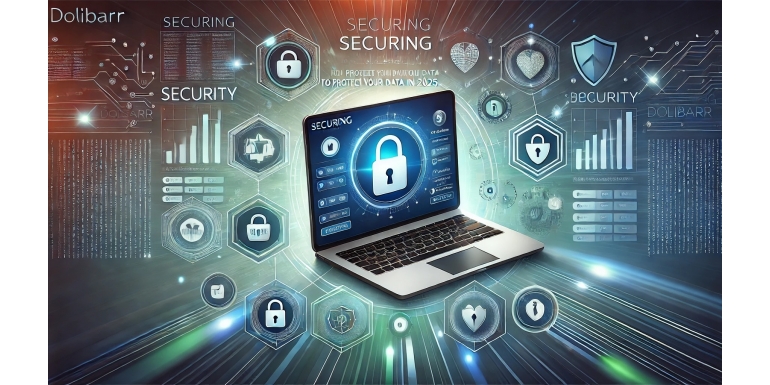
In a world where cybersecurity is a top priority, protecting a company’s data is essential, especially when using an ERP/CRM like Dolibarr. This open-source management tool is widely adopted by businesses of all sizes, making it a potential target for cyberattacks, data breaches, and unauthorized access.
In 2025, with the constant evolution of cyber threats, it is crucial to adopt security best practices to ensure the integrity, confidentiality, and availability of your data in Dolibarr, whether it is hosted on a local server or in the cloud.
In this article, we will explore the security risks associated with Dolibarr and detail the best strategies to implement in order to secure your instance effectively.
1️⃣ Why Secure Dolibarr in 2025?
✅ An ERP Solution Exposed to Cyber Threats
As a web application, Dolibarr is potentially vulnerable to common cyberattacks, including:
✔ SQL injection attacks, which aim to modify or steal data.
✔ Cross-Site Scripting (XSS) attacks, used to inject malicious code.
✔ Brute-force and dictionary attacks, attempting to crack user passwords.
✔ Exploitation of vulnerabilities in third-party modules that are outdated.
✅ Protecting Sensitive Business Data
Companies use Dolibarr to manage:
✔ Customer and supplier information.
✔ Accounting and financial data.
✔ Quotes, invoices, and banking transactions.
✔ User access and permissions.
A data breach or security compromise could have severe consequences for any business:
✔ Loss of customer trust.
✔ Legal penalties for non-compliance with GDPR and security regulations.
✔ Theft of confidential data that could be exploited by competitors or cybercriminals.
1️⃣ Best Practices to Secure Dolibarr in 2025
1. Securing Access to Dolibarr
✅ 1.1 Implement Strong Authentication
✔ Use strong passwords (at least 12 characters, including uppercase, numbers, and symbols).
✔ Enforce periodic password changes every 90 days.
✔ Limit login attempts to prevent brute-force attacks.
✔ Enable two-factor authentication (2FA) using apps like Google Authenticator.
✅ 1.2 Manage User Roles and Permissions
✔ Restrict access to Dolibarr modules based on user roles.
✔ Disable unused or inactive accounts to prevent unauthorized access.
✔ Regularly review user permissions and revoke unnecessary access.
✅ 1.3 Enable Logging and Connection Monitoring
✔ Activate login logs to track suspicious access attempts.
✔ Configure security alerts for repeated failed login attempts.
✔ Use a SIEM (Security Information and Event Management) system to centralize logs and detect anomalies.
2. Securing the Server Hosting Dolibarr
✅ 2.1 Keep Dolibarr and Modules Up-to-Date
✔ Always use the latest stable version of Dolibarr to benefit from security patches.
✔ Regularly update modules and extensions from trusted sources like Dolistore.
✔ Remove obsolete or unused modules to minimize security risks.
✅ 2.2 Secure the Hosting Environment
✔ Prefer a dedicated secure server instead of shared hosting.
✔ Set up a firewall to block unauthorized access.
✔ Activate Fail2Ban to limit brute-force attacks.
✔ Implement a Web Application Firewall (WAF) to filter malicious requests.
✅ 2.3 Secure the Database
✔ Restrict database access to authorized services only.
✔ Change the default MySQL/MariaDB port to avoid automated scans.
✔ Enable encryption of stored data for added protection.
3. Securing Communications and Data Transfers
✅ 3.1 Enforce HTTPS and SSL Certificates
✔ Ensure that Dolibarr is only accessible via HTTPS to secure communications.
✔ Use a reliable SSL/TLS certificate (Let’s Encrypt, Sectigo, etc.).
✅ 3.2 Encrypt Sensitive Data
✔ Encrypt stored data to prevent leaks in case of server compromise.
✔ Use PGP/GPG encryption for emails sent from Dolibarr.
✅ 3.3 Secure Data Backups
✔ Schedule automatic backups on a secure server.
✔ Use encrypted backup solutions to protect against ransomware attacks.
✔ Regularly test backup restorations to ensure reliability.
4. Protection Against External Threats
✅ 4.1 Anti-Malware Protection and Endpoint Security
✔ Install antivirus and anti-malware software on all devices accessing Dolibarr.
✔ Educate users on phishing risks and how to recognize malicious emails.
✅ 4.2 Monitor Anomalies and Detect Intrusions
✔ Use tools like OSSEC, Snort, or Suricata to analyze logs and detect threats.
✔ Enable real-time alerts for unauthorized access or suspicious file modifications.
5. Compliance with Regulations and Standards
✅ 5.1 Ensure GDPR Compliance and Security Regulations
✔ Ensure that stored personal data complies with General Data Protection Regulation (GDPR).
✔ Maintain a data processing registry within Dolibarr.
✔ Allow users to view, modify, and delete their personal data upon request.
✅ 5.2 Document and Train Teams on Security Best Practices
✔ Document all security procedures and distribute them to employees.
✔ Train employees on cybersecurity best practices (password management, phishing awareness, etc.).
1️⃣ Conclusion: A Secure ERP for a Protected Business
In 2025, cybersecurity should be a top priority for all businesses using Dolibarr. Implementing the security measures outlined in this article ensures optimal protection against cyber threats and data loss.
✅ By applying these best practices, you safeguard the integrity and longevity of your ERP system, comply with security regulations, and reinforce customer trust. ????
???? Have you secured your Dolibarr installation? What strategies do you use to protect your data?
